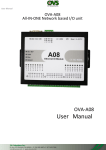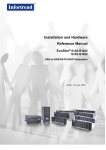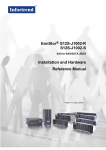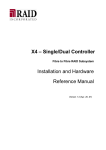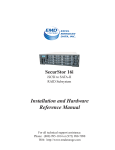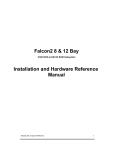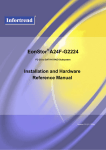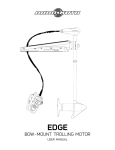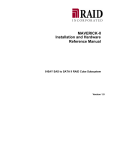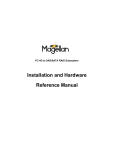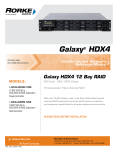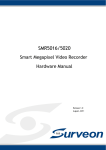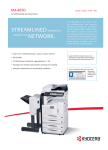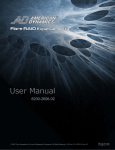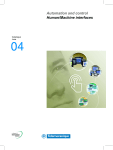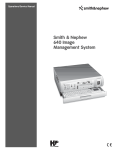Download Falcon III
Transcript
Falcon III Installation and Hardware Reference Manual Falcon III SAS to SATA-II RAID Subsystem Installation and Hardware Reference Manual Rev. 1.0 (Aug., 2009) 1 Falcon III Installation and Hardware Reference Manual Warnings and Certifications Restricted Access Location: This equipment is intended to be installed in a RESTRICTED ACCESS LOCATION only. Electric Shock Warning! To Prevent Electric Shock: Access to this equipment is granted only to trained operators and service personnel who have been instructed of and fully understand the possible hazardous conditions and the consequences of accessing non-fieldserviceable units, e.g., system backplane. CAUTION! 1. Installation of an incorrect battery to the equipment may incur risk of explosion. 2. Dispose of a used battery in accordance with the regulations by your local authorities. FCC (applies in the U.S. and Canada) FCC Class B Radio Frequency Interference Statement This equipment has been tested and found to comply with the limits for a Class B digital device, pursuant to Part 15 of the FCC Rules (47 CFR, Part 2, Part 15 and CISPR PUB. 22 Class B). These limits are designed to provide reasonable protection against harmful interference when the equipment is operated in a residential installation. This equipment generates, uses, and can radiate radio frequency energy and, if not installed and used in accordance with this user’s guide, may cause harmful interference to radio communications. However, there is no guarantee that interference will not occur in a particular installation. If this equipment does cause harmful interference to radio or television reception, which can be determined by turning the equipment off and on, you are encouraged to try to correct the interference by one or more of the following measures: Reorient or relocate the receiving antenna. Increase the separation between the equipment and receiver. Connect the equipment into an outlet on a circuit different from that to which the receiver is connected. Consult the dealer or an experienced radio/TV technician for help. This device complies with Part 15 of FCC Rules. Operation is subject to the following two conditions: 1) this device may not cause harmful 1 Falcon III Installation and Hardware Reference Manual interference, and 2) this device must accept any interference received, including interference that may cause undesired operation. Warning! A shielded power cord is required in order to meet FCC emission limits and also to prevent interference with nearby radio and television reception. Use only shielded cables to connect I/O devices to this equipment. You are cautioned that changes or modifications not expressly approved by the party responsible for compliance could void your authority to operate the equipment. This device is in conformity with the EMC. CB CCC (Certified Worldwide) This device meets the requirements of the CB standard for electrical equipment with regard to establishing a satisfactory level of safety for persons using the device and for the area surrounding the apparatus. This standard covers only safety aspects of the above apparatus; it does not cover other matters, such as style or performance. For Power Supplies’ compatibility to China Compulsory Certification. ITE BSMI Class B, CNS 13438 (for Taiwan) This device is in conformity with UL standards for safety. RAID Inc. is committed to being properly prepared and taking all the necessary steps that will result in our compliance with the new European directive, RoHS (2002/95/EC), on or before the specific dates set forth in those applicable laws and regulations. RAID Inc. is applying its own internal efforts and expertise and is working closely with customers and suppliers to achieve compliance while maintaining an uninterrupted supply of quality products. RAID Inc. is currently investigating, evaluating, and qualifying our materials and components to ensure that products sold on or after 1 July 2006, in such territory, are in compliance with the above regulations. Falcon III Installation and Hardware Reference Manual Disposal of Old Electrical & Electronic Equipment (Applicable in the European Union and other European countries with separate collection systems) This symbol on the product or on its packaging indicates that this product shall not be treated as household waste. Instead it shall be handed over to the applicable collection point for the recycling of electrical and electronic equipment. By proper waste handling of this product you ensure that it has no negative consequences for the environment and human health, which could otherwise be caused if this product is thrown into the garbage bin. The recycling of materials will help to conserve natural resources. For more details about recycling of this product, please contact your local city office, your household waste disposal service or the dealer from whom you purchased the product. This product utilizes STA standards compliant interfaces. 3 Falcon III Installation and Hardware Reference Manual Table of Contents CONTACT INFORMATION ............................................................................................II COPYRIGHT 2009 ........................................................................................................... III This Edition First Published 2009.................................................................................... iii Disclaimer ........................................................................................................................ iii Trademarks....................................................................................................................... iii WARNINGS AND CERTIFICATIONS ......................................................................... IV TABLE OF CONTENTS ................................................................................................. VII SAFETY PRECAUTIONS ................................................................................................. X Precautions and Instructions.............................................................................................. x ESD Precautions ................................................................................................................ x ABOUT THIS MANUAL ................................................................................................. XI REVISION HISTORY...................................................................................................... XI WHO SHOULD READ THIS MANUAL? ..................................................................... XI RELATED DOCUMENTATION .................................................................................... XI CONVENTIONS ............................................................................................................... XI SOFTWARE AND FIRMWARE UPDATES ................................................................ XII CHAPTER 1 INTRODUCTION 1.1 PRODUCT OVERVIEW ............................................................................................. 1-1 1.1.1 1.1.2 Product Introduction............................................................................................... 1-1 Model Variations .................................................................................................... 1-2 1.2 CHASSIS OVERVIEW ............................................................................................... 1-2 1.2.1 1.2.2 1.2.3 1.2.4 Front Panel Overview............................................................................................. 1-3 Rear Panel Overview .............................................................................................. 1-4 Internal Backplane.................................................................................................. 1-5 Physical Dimensions ............................................................................................... 1-5 1.3 MAJOR SUBSYSTEM COMPONENTS ........................................................................ 1-5 1.3.1 1.3.2 1.3.3 1.3.4 1.3.4.2 1.3.5 1.3.6 LCD keypad Panel .................................................................................................. 1-6 Drive Tray............................................................................................................... 1-7 The RAID Controller Module ................................................................................. 1-7 Special Firmware Implementations ........................................................................ 1-7 Controller Module Interfaces ................................................................................. 1-8 PSUs ....................................................................................................................... 1-9 Cooling Modules................................................................................................... 1-10 1.4 ENCLOSURE MONITORING ................................................................................... 1-11 1.4.1 1.4.2 1.4.3 I2C bus .................................................................................................................. 1-11 LED Indicators ..................................................................................................... 1-11 Audible Alarms ..................................................................................................... 1-11 1.5 HOT-SWAPPABLE COMPONENTS .......................................................................... 1-12 1.5.1 1.5.2 CHAPTER 2 Hot-swap Capabilities .......................................................................................... 1-12 Components .......................................................................................................... 1-12 HARDWARE INSTALLATION 2.1 INTRODUCTION ....................................................................................................... 2-1 2.2 INSTALLATION PREREQUISITES ............................................................................. 2-1 2.3 SAFETY PRECAUTIONS ............................................................................................ 2-2 2.3.1 2.3.2 2.3.3 Precautions and Instructions .................................................................................. 2-2 Static-free Installation ............................................................................................ 2-4 Preparation............................................................................................................. 2-4 2.4 GENERAL INSTALLATION PROCEDURE .................................................................. 2-4 2.4.1 Installation Procedure Flowchart........................................................................... 2-5 2.5 UNPACKING THE SUBSYSTEM ................................................................................. 2-6 2.5.1 2.5.2 Preinstalled Components ........................................................................................ 2-6 Modules to be Installed ........................................................................................... 2-6 Falcon III Installation and Hardware Reference Manual 2.6 HARD DRIVE INSTALLATION .................................................................................. 2-7 2.6.1 2.6.2 Hard Drive Installation Prerequisites..................................................................... 2-7 Drive Installation .................................................................................................... 2-8 2.7 DRIVE TRAY INSTALLATION .................................................................................. 2-9 2.8 OPTIONAL BATTERY MODULE INSTALLATION.................................................... 2-12 2.8.1 2.8.2 BBU Warnings and Precautions ........................................................................... 2-12 Installation Procedure .......................................................................................... 2-12 2.9 RACKMOUNTING ................................................................................................... 2-15 CHAPTER 3 SUBSYSTEM CONNECTION 3.1 HOST CONNECTION PREREQUISITES ..................................................................... 3-1 3.1.1 The Host Link Cables...................................................................................................... 3-1 3.2 TOPOLOGY AND CONFIGURATION CONSIDERATIONS ........................................... 3-3 3.2.1 Basic Configuration Rules .............................................................................................. 3-3 3.3 SAMPLE TOPOLOGY ................................................................................................ 3-4 CHAPTER 4 SYSTEM OPERATION AND MONITORING 4.1 POWER ON .............................................................................................................. 4-1 4.1.1 4.1.2 4.1.3 4.1.4 Check List ............................................................................................................... 4-1 Power On Procedure .............................................................................................. 4-2 Power On Status Check .......................................................................................... 4-2 LCD Screen............................................................................................................. 4-3 4.2 POWER OFF PROCEDURE ....................................................................................... 4-5 4.3 SYSTEM MONITORING OVERVIEW ......................................................................... 4-5 4.4 STATUS-INDICATING LEDS .................................................................................... 4-7 4.4.1 LED Overview ........................................................................................................ 4-7 4.4.2 LCD Keypad Panel ................................................................................................. 4-7 4.4.3 Drive Tray LEDs..................................................................................................... 4-9 4.4.4 Controller Module LEDs ...................................................................................... 4-10 4.4.4.1 Controller Status LEDs......................................................................................... 4-10 4.4.4.2 SAS Port LEDs..................................................................................................... 4-11 4.4.4.3 Restore Default LED ............................................................................................ 4-11 4.4.4.4 LAN Port LEDs .................................................................................................... 4-11 4.4.5 BBU LED .............................................................................................................. 4-12 4.4.6 PSU LEDs ............................................................................................................. 4-12 4.4.7 Cooling Module LEDs .......................................................................................... 4-13 4.5 AUDIBLE ALARM ................................................................................................... 4-14 4.5.1 CHAPTER 5 Failed Devices ...................................................................................................... 4-13 SYSTEM MAINTENANCE 5.1 OVERVIEW .............................................................................................................. 5-1 5.1.1 5.1.2 About Subsystem Maintenance................................................................................ 5-1 General Notes on Component Replacement............................................................ 5-2 5.2 REPLACING A CONTROLLER MODULE................................................................... 5-3 5.2.1 5.2.2 5.2.3 Considerations ........................................................................................................ 5-3 Removing the Controller Module............................................................................ 5-4 Replacing the Controller Module ........................................................................... 5-5 5.3 DIMM MODULE REPLACEMENT ........................................................................... 5-6 5.3.1 5.3.2 DIMM Module Considerations ............................................................................... 5-6 DIMM Module Upgrade/Replacement Procedure .................................................. 5-6 5.4 REPLACING A FAULTY BBU ................................................................................... 5-8 5.5 REPLACING A FAULTY PSU.................................................................................. 5-11 5.5.1 5.5.2 PSU Overview....................................................................................................... 5-11 Replacing the PSU ................................................................................................ 5-11 5.6 COOLING MODULE MAINTENANCE ..................................................................... 5-14 5.6.1 5.6.2 Notes on Cooling Module Maintenance................................................................ 5-14 Replacing a Cooling Module ................................................................................ 5-15 5.7 REPLACING A FAILED HARD DRIVE ..................................................................... 5-16 5.7.1 5.7.2 5 Hard Drive Maintenance Overview ...................................................................... 5-16 Replacing a Hard Drive ........................................................................................ 5-16 Falcon III Installation and Hardware Reference Manual APPENDIX A SPECIFICATIONS A.1 TECHNICAL SPECIFICATIONS ........................................................................... A-1 A.2 FUNCTIONAL SPECIFICATIONS ......................................................................... A-3 A.3 POWER SUPPLY SPECIFICATIONS ..................................................................... A-4 A.4 COOLING MODULE SPECIFICATIONS ............................................................... A-4 A.5 RAID MANAGEMENT........................................................................................ A-5 A.6 FAULT TOLERANCE MANAGEMENT ................................................................. A-6 APPENDIX C PINOUTS C.1 SAS CONNECTOR PINOUTS............................................................................... C-1 C.2 COM1 SERIAL PORT CABLE ............................................................................ C-2 C.2.1 C.2.2 COM1 Serial Port Cable ........................................................................................ C-2 COM2 Serial Port Cable to UPS ............................................................................ C-3 C.3 NULL MODEM ................................................................................... C-4 C.4 ETHERNET PORT PINOUTS................................................................................ C-5 C.5 POWER CONNECTORS ....................................................................................... C-5 1 Falcon III Installation and Hardware Reference Manual Safety Precautions Precautions and Instructions Provide a soft and clean surface to place your subsystem on before working on it. Servicing on a rough surface may damage the exterior of the chassis. If it is necessary to transport the subsystem, repackage all the disk drives separately using the original packaging materials. The Falcon III subsystem comes with numerous drive bays. Leaving any of these drive bays empty will seriously affect the efficiency of the airflow through the enclosure interior, and will consequently lead to system overheating and irreparable damage. Prior to powering on the subsystem, ensure that the correct power range is being used. All modules must be properly installed before powering on the subsystem. If a cooling module is missing, the heat will quickly accumulate within the chassis and other components may malfunction. If a module fails, leave it in place until you have a replacement unit and you are ready to replace it. Handle the subsystem modules using their retention screws, eject levers, and the metal frames/ faceplates. Avoid touching the PCB boards and connector pins. Airflow Consideration: The subsystem requires airflow clearance, especially at the front and rear. an Be sure that the rack cabinet into which the subsystem chassis will be installed provides sufficient ventilation channels and airflow circulation around the subsystem. To comply with requirements, do NOT modules. Make sure all are securely in place safety, emission, or thermal remove the covers or replaceable enclosure modules and covers during operation. ESD Precautions Observe all conventional anti-ESD (Electro-Static Discharge) methods when handling the system modules. It is recommended to use a grounded wrist strap and an anti-static work pad. Avoid dust and debris in your work area. Falcon III Installation and Hardware Reference Manual About This Manual This manual: Introduces the Falcon III RAID subsystem series. Describes all active components in the subsystem. Provides recommendations installation processes. and details about the hardware Briefly describes how to monitor the subsystem. Describes how to maintain the subsystem. This manual does not: Describe non-user-serviceable components. Describe the configuration options of the firmware, using terminal emulation programs, or the RAIDWatch GUI that came with your subsystem. Give a detailed description of the RAID controllers embedded within the subsystem. Revision History Rev. 1.0 Rev. 1.1 Initial Release Corrected spare parts list Who should read this manual? This manual assumes that its readers are experienced with computer hardware installation and are familiar with storage enclosures. Related Documentation RAID Subsystem Operation Manual (firmware) RAIDWatch User’s Manuals (Java-based or the firmwareembedded browser-based versions) These two (2) documents are located in the product utility CD included with your subsystem package. Conventions Naming The Falcon III series is hereafter referred to as simply the “subsystem” or the “enclosure”; and Falcon III can be abbreviated as “ES”. 3 Falcon III Installation and Hardware Reference Manual Lists Bulleted Lists: Bulleted lists are statements of non-sequential facts. They can be read in any order. Each statement is preceded by a round black dot “”. Numbered Lists: Numbered lists are used to describe sequential steps you should follow in order. Important information that users should be aware of is indicated with the following icons: NOTE: These messages inform the reader of essential but non-critical information. These messages should be read carefully as any directions or instructions contained therein can help you avoid making mistakes. CAUTION! Cautionary messages should also be heeded to help you reduce the chance of losing data or damaging the system. IMPORTANT! Important messages help you avoid erroneous configurations and hardware faults. WARNING! Warnings appear where overlooked details may cause damages to the equipment or result in personal injury. Warnings should be taken seriously. Software and Firmware Updates Please contact your system vendor or visit RAID Inc.’s VIP room website (http://viproom.RAID Inc..com.tw/index.asp) for the latest software or firmware updates. Problems that occur during the updating process may cause unrecoverable errors and system downtime. Always consult technical personnel before proceeding with any firmware upgrade. xii Chapter 1 Introduction 1.1 1.1.1 Product Overview Product Introduction This hardware manual briefly introduces the Falcon III SAS (Serial Attached SCSI)-to-SATA (Serial ATA) RAID enclosure that provides RAID protection with Serial ATA (SATA II) disk drives. The enclosure comes with the host-side connectivity of eight (8) PHYs via two (2) 4x wide mini-SAS connectors (4 PHYs in a single quad port) and supports twelve (12) or eight (8) hotswappable SATA disk drives. The enclosure is managed by a single RAID controller that provides complete RAID functionalities and the computing power to accelerate data flow Figure 1-1: Falcon III 12-Bay Enclosure between host and individual disk drives. Component operating statuses are closely monitored and reported through a proprietary enclosure service and the powerful Java- or browser-based RAIDWatch manager. In terms of physical connection, the SAS interface provides ease of cabling through Mini SAS, SFF-8088, 4x wide receptacle connectors. Each SAS PHY within is capable of a 3.0 Gbps data rate. Dual-redundant power supplies and cooling modules protect the subsystem from the down time caused by single module failure. Power supply units (PSU) share load in a dual-redundant configuration, and is able to sustain system operation in the event of single power supply failure. The modular nature of the subsystem and the easy accessibility to all major components ensure that faults can be corrected online within a few seconds. Falcon III Installation and Hardware Reference Manual NOTE: On receiving and unpacking your subsystem, please check the package contents against the included Unpacking List. If any module is missing, please contact your subsystem vendor immediately. 1.1.2 Model Variations Model A12S-G2130 A08S-G2130 Controller IFT-82AS21GE12 x 1 IFT-82AS21GE08 x 1 Controller Configuration Single Single SAS Ports 2 2 Drive Bays 12 8 Power Supplies 2 2 Cooling Modules 3 2 Table 1-1: Falcon III A12S and A08S Model Variations Both models come with a single RAID controller. These models cannot be upgraded into a dual-redundant controller subsystem by adding a second controller. The docking bay for the second controller module is covered by a metal plate that should never be removed so that the internal airflow is not interrupted. One visible difference between the 12-bay A12S and the 8-bay A08S models is the metal plate covering the reserved drive slots in the bottom drive row on the A08S model. Because of the higher disk drive density, the A12S is equipped with an additional cooling module underneath the RAID controller. 1.2 Chassis Overview The A12S and A08S chassis is built with rugged steel in a standard 19” 2U profile. The chassis is divided into the front and rear sections. Due to the wide varieties of rackmount options, rackmount rails are provided as optional accessories. You can locate all major components in the following sections. NOTE: Components accessed through the front panel are referred to as “Front Panel Components” and components accessed through the rear panel are referred to as “Rear Panel Components”. Chapter 1: Introduction 1.2.1 Front Panel Overview The front section of the subsystem features a 4 x 3 or 4 x 2 layout for housing twelve (12) or eight (8) 3.5-inch drives. Two (2) forearm handles on the sides of the chassis help with retrieving the chassis from a rack cabinet. A comprehensive LCD keypad panel provides access to all embedded firmware functionalities. The front views of the enclosures are shown below: Figure 1-2: Falcon III 12-Bay Enclosure Front View Figure 1-3: Falcon III 8-Bay Enclosure Front View Drive bays with drive tray canisters: The subsystem comes with twelve (12) or eight (8) drive bays in the front section of the chassis. LCD keypad panel: The LCD panel is mounted on the left-side forearm handle. The panel comes with status LEDs, function keys, and a mute button. Falcon III Installation and Hardware Reference Manual 1.2.2 Rear Panel Overview The enclosure rear views are shown below. The rear panel provides access to all enclosure components. A description of each rear panel component is given below: Figure 1-4: Falcon III Enclosure Rear View Figure 1-5: Falcon III Enclosure Rear View RAID controller module: One (1) controller module is installed in the Falcon III. Each controller contains a main circuit board, which processes I/O requests and RAID parity computation for data protection and provides high data throughput for application servers. (See Section 1.3.3.) PSUs: The hot-swappable PSUs supply power to the subsystem. Power on/ off is controlled by the individual power switches on the power supplies. (See Section 1.3.4.) Cooling Modules: The redundant cooling modules ventilate the system with an airflow direction from the front to the rear. The Falcon III 12-Bay model comes with three (3) cooling modules. Chapter 1: Introduction 1.2.3 Internal Backplane An integrated backplane board separates the front and rear sections of the chassis. This backplane provides logic level signals and low 2 voltage power paths. Thermal sensors and I C serial paths are implemented in order to receive temperature/ voltage readings and module presence signals. This board contains no userserviceable components. 1.2.4 Physical Dimensions The A12S/ A08S subsystem comes in an enhanced 2U chassis with the following dimensions: Measured with forearm handles: Measured without forearm handles: 1.3 482mm x 88mm x 516mm (width x height x depth) 446mm x 88mm x 498mm (width x height x depth) Major Components The subsystem houses many active components and most of them can be accessed either through the front or the rear panel. The modular design of these components facilitates their easy installation and removal. Hot-swap mechanisms are incorporated to eliminate power surges and signal glitches that might occur when removing or installing these modules. Each component is further described below: Major Components 1-5 Falcon III Installation and Hardware Reference Manual 1.3.1 LCD Keypad Panel LCD Panel Figure 1-6: LCD Keypad Panel The LCD panel shown in Figure 1-6 consists of a 16 characters x 2 rows LCD screen with push buttons, a mute button, and LED status indicators. The LCD front panel provides full access to all configuration and monitoring options. After powering up the subsystem, the initial screen displays the subsystem model name. A different name can be manually assigned to the subsystem or to different RAID arrays. This enables easier identification in a topology consisting of numerous arrays. Figure 1- 7: Forearm Handle Retention Latches To access drive bays in the left- or right-hand side column, release the retention latches by pushing them outwards (see Figure 1- 7), and then swing the forearm handles to the sides. To close the handles (see Figure 1- 8), swing the forearm handles towards the center; gently press the handles until a click sound is heard. The latches will lock the handles in place. Figure 1- 8: Closing the Front Handles Chapter 1: Introduction 1.3.2 Drive Tray Figure 1-9: Drive Tray Front View The enclosure comes with drive trays (see Figure 1-9) designed to accommodate separately purchased, standard 1-inch pitch, 3.5inch SATA II disk drives. The drive bays are accessible from the front side of the chassis. Two (2) LEDs on the tray bezel indicate operating statuses. A rotary bezel lock prevents accidental removal, while a convenient release button ensures fast and efficient drive swapping. There are screw holes on the sides of the drive tray for securing hard drives to the drive tray. WARNING! Be careful not to warp, twist, or contort the drive tray in any way (e.g., by dropping it or resting heavy objects on it). The drive tray has been customized to fit into the drive bays in the subsystem. If the drive bay superstructure is deformed or altered, the drive trays may not fit properly into the drive bay. The diagram below shows drive bays that are numbered from Slot 1 to Slot 12 (see Figure 1-10), from left to right, and then from top to bottom. This numbering sequence is important for identifying and replacing a disk drive. Replacing a wrong drive can fatally fail a RAID3 or RAID5 logical array. Figure 1-10: Drive Bay Numbering Sequence Falcon III Installation and Hardware Reference Manual 1.3.3 The RAID Controller Module Figure 1-11: RAID Controller Module The RAID controller contains a main circuit board and a faceplate providing external interfaces. Components contained within the controller are non-user-serviceable. Except when replacing a failed controller or replacing its DIMM module, the controller module should never be removed or opened. 1.3.3.1 Controller Module Interfaces The controller interfaces are accessed controller faceplate as shown in Figure 1-12. through the Figure 1-12: Controller Faceplate SAS Host Ports: Each RAID controller features two (2) SAS ports labeled CH0 (Channel 0) or CH1 (Channel 1). The 4PHY, wide SAS ports comply with the SFF-8088 specification. Each quad port comprises the connectivity of 4 PHYs with Gigabits of host link bandwidth. Each subsystem comes with one (1) host link cable. Chapter 1: Introduction Status LEDs: These LEDs display various operating statuses. Please refer to Chapter 4 for more information. 1.3.4 PSUs Figure 1-13: PSU Canister The subsystem is equipped with two (2) redundant, hot-swappable, 350W PSUs, which are located at the enclosure’s rear section. (See Figure 1-4) The PSU is permanently mounted into a 2U canister especially designed to contain both the PSU and a cooling module. If the PSU is removed, the cooling module is also removed. As shown in Figure 1-13, each PSU comes with a power socket for power cord connection and an on/ off power switch. A single LED indicates the PSU status. For LED definitions, please refer to Section 4.4.9. When a PSU fails, the LED is lit constantly red. A handle above the PSU enables you to safely install the PSU into or retrieve it from the chassis. A retention screw helps secure the PSU within the chassis slot. To remove the PSU, the retention screw must be removed first. When installing a PSU, make sure the retention screw is firmly secured. For detailed specifications to Appendix A.4. of the power supply, please refer Falcon III Installation and Hardware Reference Manual 1.3.5 Cooling Modules Figure 1-14: Cooling Module The enclosure is equipped with three or two redundant, cooling modules. (See Figure 1-14.) Each module comes with a blower. The LED on each canister indicates the cooling fan’s operating status. Intelligent Dual Speed Operation The cooling fans in the cooling module operate at two rotation speeds. Under normal operating conditions, the cooling fans rotate at the low speed, which maintains a sufficient airflow across the components. Under the following conditions, the cooling fans will raise their rotation speed to increase the airflow: 1. Component failure: if a fan in a cooling module, a PSU, or a temperature sensor fails, the remaining cooling fan(s) automatically raises its rotation speed. 2. Elevated temperature: if any of the temperature readings breaches the upper threshold set for any of the interior temperature sensors, the cooling fans automatically raise their rotation speed. 3. During the subsystem initialization stage, the cooling fans operate at the high speed and return to low speed once the initialization process is completed and no erroneous condition is detected. NOTE: There are two value sets for the upper temperature thresholds. One is set for event notification and the other triggers higher fan rotation speed. The preset value for event notification can be changed using the firmwareembedded configuration utility, while the fan speed trigger is not a user’s option. Please refer to the firmware Operation Manual for the options with event notification values. Falcon III Installation and Hardware Reference Manual 1.4 Enclosure Monitoring The enclosure comes with a number of different monitoring methods to provide you with continual updates on the status of the system and the individual components. The following monitoring features are included in the subsystem. 1.4.1 I2C bus The following subsystem elements are RAID 2 controller over a non-user-serviceable I C bus: interfaced to the PSUs Cooling modules Temperature sensors and backplane board) (resided on the controller board Presence detection circuitry 1.4.2 LED Indicators The following active components come with LEDs to indicate the status of individual components. Please refer to Chapter 4 for more information on System Monitoring. LCD keypad panel (three status LEDs) Drive trays (two LEDs on each tray) RAID controller, each module has six (6) LEDs and one (1) LED specifically for the Restore Default Functionality Each SAS host port comes with an LED for link status Cooling modules (one LED) PSUs (one LED on each module) 1.4.3 Audible Alarms The enclosure comes with audible alarms that are triggered when certain active components fail or when certain subsystem thresholds are exceeded. Whenever you hear an audible alarm from the enclosure, it is imperative that you determine the cause and rectify the problem immediately. Event notification messages indicate the completion or status of array configuration tasks and are always accompanied by two (2) or three (3) successive and prolonged beeps. Enclosure Monitoring 1-11 Chapter 1: Introduction WARNING! Failing to respond to a sounding audible alarm can lead to permanent damage of the enclosure components. When an audible alarm is heard, rectify the problem as soon as possible. 1.5 Hot-swappable Components Proper cooling is referred to as “normalized” airflow. Normalized airflow ensures sufficient cooling of the subsystem and is only attained when all components are properly installed. Therefore, a failed component should only be removed when a replacement is available. If a failed component is removed but not replaced, permanent damage to the subsystem can result. 1.5.1 Hot-swap Capabilities The enclosure comes with a number of hot-swappable components that can be exchanged while the subsystem is still online without affecting the operational integrity of the subsystem. These components should only be removed from the subsystem when they are being replaced. Do NOT remove these components from the enclosure unless necessary. 1.5.2 Components The following components are hot-swappable: Cooling modules Power supplies Hard disk drives Battery modules NOTE: Please refer to Chapter 5 for the instructions on replacing the hotswappable components. Chapter 2 Hardware Installation 2.1 Introduction This chapter gives detailed instructions on how to install hard drives and drive trays into the subsystem. Installation into a rack or cabinet should occur before the hard drives or drive trays can be installed into the subsystem. Please confirm that you received all of the components listed on a printed copy of Unpacking List that came with the subsystem before proceeding with the installation process. CAUTION! Follow the installation instructions described in this manual carefully to prevent any difficulties and damages to your subsystem. 2.2 Installation Prerequisites 1. Static-free installation environment: The enclosure must be installed in a static-free environment to minimize the possibility of electrostatic discharge (ESD) damage. (See Section 2.3) 2. Component check: Before installing the enclosure, check that you have received all the required components. (See Section 2.5) If any items appear damaged, contact your vendor for a replacement. 3. Hard drives: Up to twelve (12) SATA II hard drives must be purchased separately and the hard drives should be available prior to installing the enclosure. (See Section 2.6) 4. Cabling: One (1) Mini SAS to Mini SAS, 4x-to-4x, SFF-8088 compliant, 120cm SAS external cable is shipped with the enclosure. An optional Mini SAS-toInfiniband cable is also available. Use the cable to connect the subsystem to an application server. Please see Chapter 3 for sample topologies and configuration options. 5. Rack installation: The enclosure chassis can be installed into a rack cabinet using separately purchased mounting rails, rear- attached brackets, or RAID Inc.’s rackmount rails. (See Section 2.9) Falcon III Installation and Hardware Reference Manual 2.3 2.3.1 Safety Precautions Precautions and Instructions 1. Please disconnect two (2) power cords from AC outlets before servicing or cleaning. Do NOT use liquid or sprayed detergent for cleaning. Use a slightly moistened paper towel or clothe for cleaning. 2. Hard drives should be removed from the enclosure if you need to relocate them. 3. Rack-mounting the enclosure – The subsystem is intended to be rack-mounted, the following concerns should be heeded when installing the enclosure into a rack cabinet. a. The rack cabinet and the associated equipment at the installation site should be able to maintain an ambient temperature (around the chassis) lower than 40C or 35C if a battery backup module is applied. b. The openings on the enclosure are for air convection through the interior of the chassis. Do not cover the openings. c. The rack cabinet must support over-current protection and must not be overloaded by the modules installed. Other requirements, such as ventilation airflow, rack stabilizing features, electrical earth, and electrical distribution, must comply with the technical specifications listed in the documentation or safety label that came with this product. d. Power source and the equipment rack must be grounded. e. Consideration should be given to the connection of the RAID subsystem to the supply circuit and the effect that overloading of circuits might have on the over-current equipment nameplate ratings should be used when addressing this concern. 2-2 4. Place the enclosure on a soft, clean surface before working on it. Placing the enclosure on a rough surface during servicing may damage the chassis finish. 5. Do not remove any module or component from its anti-static bag to prevent damage to the electric components. 6. Because hard drives are prone to damage due to shock and vibration during operation, all hard drives should be installed in a rack cabinet before powering up. 7. Do NOT stack the hard drives on top of each other without their protective drive trays. Even when the drives are installed in the drive trays, contact with the exposed PCB or interface pins may Safety Precautions Chapter 2: Hardware Installation result in ESD damage which will yield various immediate or latent failures. 8. IC Stacking drives one upon another can result in erasing the programmable contents. 9. When replacing components, insert them as gently as possible while assuring full engagement. Vibration and shock can easily damage hard drives during operation. Handle the hard drives with extreme care. 10. Place the power cords and all cables away from foot traffic. Do not place anything over the power cords. After all equipment is installed in a rack, carefully route the power cords and data cables so that power cords are not resting against data cables. 11. If the enclosure is not used for a long time, disconnect it from mains to avoid transient over-voltage. 12. Never open the enclosure chassis. For safety reasons, only qualified service personnel should open the equipment. 13. If any of the following situations occurs, contact the service personnel: a. The power cord or plug is damaged. b. The equipment has been exposed to moisture. c. The enclosure does not function properly or you cannot get it work according to this manual. d. The enclosure has been dropped against a hard surface. e. The enclosure shows obvious signs of breakage. 14. Thermal notice: All drive trays (even if they do not contain a hard drive) must be installed into the enclosure. Leaving a drive bay or module slot open will seriously affect the airflow efficiency, and consequently lead to overheating. Keep a faulty module in place until you have a replacement unit and are ready to replace it. 15. An enclosure without disk drives can weigh more than 20 kilograms (44 lbs). Two people will be required to install or relocate the subsystem. 16. Airflow considerations: The subsystem requires an airflow clearance especially at the front and rear. For proper ventilation, a minimum of 2.5cm (1 inch) is required for the distance between the front of the enclosure and rack cover; a minimum of 10cm (4 inches) is required for the distance between the enclosure and the rear wall of the cabinet. 17. Handle the system modules by the retention screws, ejection levers, or the module’s metal frame/ faceplate only. Avoid touching the PCB boards or connector pins. Falcon III Installation and Hardware Reference Manual 18. Always secure every enclosure module with its retaining screws or make sure it is held in place by its retention latches or ejection levers. 19. When working with the subsystem, use the tools with care. Do not place the tools or other items on top of the enclosure to avoid damaging the outward appearance. 20. If it is necessary to transport the subsystem, remove and repackage all the disk drives separately. 2.3.2 Static-free Installation Static electricity can damage electronic components. To prevent ESD damage to any of the components, follow these precautions before touching or handling them: Discharge the static electricity accumulated in your body by wearing an anti-static wristband. Avoid carpets, plastic, vinyl, and Styrofoam in your work area. Handle all components by holding their edges or metal frames. Avoid touching the exposed circuitry on PCB boards and connector pins. 2.3.3 Preparation Make sure you are aware of the related positions of each plug-in module and interface connector. Cables must be handled with care and must not be bent. To prevent emission interference within a rack system and accidental cable disconnection, the routing path must be carefully planned. 2.4 General Installation Procedure Following all the instructions below can minimize subsystem installation time. Detailed and illustrated instructions for each component are given in the following sections. 2-4 1. Unpack: Unpack the enclosure and confirm that all components on the list were included. (See Section 2.5) 2. Rack/ Cabinet installation: If the subsystem is going to be installed in a rack or cabinet, it should be installed prior to installing the hard drives. Installing the subsystem into a rack or cabinet requires at least two (2) people. (See Section 2.9) 3. Install hard drives: Separately purchased SATA II interface hard drives must be individually installed into the drive trays. (See Section 2.6) General Installation Procedure Chapter 2: Hardware Installation 4. Install drive trays: After the hard drives have been installed into the drive trays, install the drive trays into the enclosure itself. (See Section 2.7) 5. Cable connection: Use the supplied power cords to connect the subsystem to the main power. It is recommended to connect power cords to separate and independent power sources for higher redundancy; e.g., a UPS device. Make sure your subsystem is electrically grounded. CAUTION! Handle the cables for connecting SAS devices with care. They must not be bent, frayed, or twisted; and the routing paths must be carefully planned to prevent emission interference within a rack system. 6. Power up: Once the components have been properly installed and all cables are properly connected, you can power up the subsystem and configure the RAID array. (See Section 4.1) 2.4.1 Installation Procedure Flowchart Figure 2-1 shows a flowchart of the installation procedure. As you complete each step, check off the “Done” box on the right. Please use this flowchart in conjunction with the instructions that follow. Figure 2-1: Installation Flowchart Falcon III Installation and Hardware Reference Manual 2.5 Unpacking the Subsystem Compare the Unpacking List against the actual package contents to confirm that all required materials have arrived. Carefully check the items contained in each box before proceeding with installation. WARNING! Do not rely on the non-definitive, summarized unpacking list shown below, it is for reference only. A detailed packing list can be found in your product shipping package or product CD. Each shipping package is divided into upper and lower levels. Upper level box contents: twelve (12) or eight (8) drive canisters Lower level contents: Three (3) boxes are placed in the lower level. One (1) box contains the enclosure chassis with all the pre-installed components. The other two (2) boxes contain the power cords and accessory items. Accessory items include an RS-232C serial cable, null modem, Quick Installation Guide, screws, and a CD containing the RAIDWatch Manager software and its manuals, Installation and Hardware Reference Manual (this document), Application Note, and the RAID Subsystem Operation Manual (for firmware- embedded configuration utility). 2.5.1 Preinstalled Components The followings are pre-installed components: 1 - LCD keypad panel 2 - Forearm handles 1 - Backplane board 1 - Controller module 2 - PSUs 3 or 2 - Cooling modules 2.5.2 Modules to be Installed Hard drives are delicate and should be installed onsite: Hard drives (separately purchased SATA II drives) Drive trays Host-side connections (please refer to Chapter 3) Battery Backup module (optional) Chapter 2: Hardware Installation 2.6 2.6.1 Hard Drive Installation Hard Drive Installation Prerequisites Hard drives should be purchased separately. When selecting hard drives, the following factors should be considered: Capacity (MB/GB): Use drives with the same capacity. RAID arrays use a “least-common-denominator” approach meaning the maximum capacity used in each drive for comprising a logical configuration is the maximum capacity of the smallest drive. Therefore, choose large capacity hard drives with the same storage capacity. Profile: The enclosure drive bays are designed for 3.5-inch wide x 1inch pitch hard drives. Drive Interface Type: The enclosure is designed to accommodate SATA II hard drives. CAUTION! The hard drives and drive trays should only be installed into the subsystem after the subsystem is mounted into a rack cabinet. If the hard drives are installed first, the subsystem will be too heavy to handle and the hard drives may be damaged when installing the subsystem. WARNING! 1. Handle the hard drives with extreme care. Hard drives are very delicate. Dropping a drive onto a hard surface (even over a short distance) and hitting or touching the circuits on the drives with your tools may damage the hard drives. 2. Observe all ESD prevention methods when installing the hard drives. 3. Only use the screws supplied in the shipping package. Longer screws may damage the hard drives. Falcon III Installation and Hardware Reference Manual 2.6.2 Drive Installation Step 1. Place the hard drive into the drive tray (as shown in Figure 2-2). Make sure the interface connector is facing the open side of the drive tray, and the label side facing up. Figure 2-2: Installing a Hard Drive Step 2. Adjust the drive’s location until the mounting holes in the drive canister are aligned with those on the hard drive. The interface connector should be flushed with the end of drive tray. Step 3. Secure the disk drive with four (4) of the supplied 6/32 flat-head screws. (See Figure 2-2) Step 4. Once the hard drives are installed into the drive trays, install all drive trays into the enclosure. See detailed instructions in the following section. Chapter 2: Hardware Installation 2.7 Drive Tray Installation Once the hard drives have been installed in the drive trays, the drive trays are ready to be installed into the subsystem. WARNING! All drive trays must be installed into the enclosure even if they do not contain a hard drive. If the trays are not installed into the enclosure, the ventilation required for cooling will not be normalized and the subsystem will overheat. Step 1. Make sure the rotary bezel lock is in the unlocked position, i.e., the groove on its face is in a horizontal orientation as shown in Figure 2-3. If the groove is in a vertical position, the key-lock is locked and the front bezel on the drive tray cannot be opened. Figure 2-3: Front View of an Individual Drive Tray Step 2. Open the front flap on the drive tray (see Figure 2-4) by pushing the release button on the front flap. The front flap will automatically swing open. Figure 2-4: Opening the Drive Tray Front Flap Falcon III Installation and Hardware Reference Manual Step 3. Align the drive tray with the tray slot into which you want to insert. Make sure it is properly aligned, and then gently slide it in. This should be done smoothly and gently. (See Figure 2-5) CAUTION! Slamming the drive tray into the chassis can damage the back-end connector. Figure 2-5: Installing a Drive Tray Step 4. Close the front flap of the drive tray. Make sure the front flap is closed properly to ensure that the connector at the back of the hard drive is firmly connected to the corresponding connector on the backplane board. If the front flap is not closed properly, the connection between the hard drive and the subsystem will not be secure. Figure 2-6: Closing the Front Flap Chapter 2: Hardware Installation Step 5. bezel Lock the flap into place by turning the rotary lock until the groove on its face down (vertical orientation). (See Figure 2-7) is pointing Figure 2-7: Drive Tray Lock Rotation Step 6. Once all drive trays are properly installed, the subsystem will recognize the disk drives and scan them in automatically during the power-on procedure. Falcon III Installation and Hardware Reference Manual 2.8 Optional Battery Module Installation The BBU can sustain cache memory in the event of a power failure or in the extremely unlikely event of failing both PSUs. The use of a BBU is highly recommended in order to avoid data inconsistency. The BBU is an optional item for the series and can be ordered separately from RAID Inc. Read the BBU handling precautions in Section 2.8.1 before replacing it. Please follow the steps in Section 2.8.2 to install a BBU into your system. 2.8.1 BBU Warnings and Precautions Install or replace the BBU with the BBUs supplied by your vendors only. Use of battery cells provided from another source will void your warranty. Always dispose of used batteries in an ecologically responsible manner at authorized battery disposal sites only. Do NOT use or leave the BBU near a heat source. Heat can melt the insulation and damage other safety features of the battery cells, possibly causing an acid leak and may result in a fire or explosion. Do not immerse the BBU in water or allow it to get wet. Its protective features can be damaged and abnormal chemical reactions may occur, possibly causing functional defects, acid leaks, and other hazardous results. Do not disassemble or modify the BBU. If disassembled, the BBU could leak acid, overheat, emit smoke, burst and/ or ignite. Do not pierce the BBU with a sharp object, strike it with a hammer, step on it, or throw it. These actions could damage or deform it and internal short-circuiting can occur, possibly causing functional defects, acid leaks, and other hazardous results. If a BBU leaks, gives off a bad odor, generates heat, becomes discolored or deformed, or in any way appears abnormal during use, recharging or storage, immediately remove it from the subsystem and stop using it. If this is discovered when you first use the BBU, please return it to RAID Inc. or your system vendor. 2.8.2 Installation Procedure To install a BBU into the controller module, please follow these steps: Step 1. Remove the BBU slot dummy cover from the chassis by loosening the retention screws using a Chapter 2: Hardware Installation medium-sized Phillips screwdriver, and then pulling the dummy cover away. (See Figure 2-8) Figure 2-8: Removing the BBU Dummy Cover Step 2. Install a BBU by aligning it with the module slot, and then gently pushing the BBU until it is fully inserted. Step 3. Secure the BBU to the subsystem by fastening the retention screws on the BBU. (See Figure 2-9) Figure 2-9: Installing the BBU Step 4. The LED should start flashing to indicate that the BBU is being charged. When the BBU is fully charged, the LED will turn off. (See Figure 2-10) Figure 2-10: BBU LED Step 5. Reset the subsystem for the configuration change to take effect if the BBU is added online. NOTE: 1. A new or replaced BBU takes at least 12 hours to charge to its full capacity. Falcon III Installation and Hardware Reference Manual 2. You may check the BBU-related event messages on the LCD screen or your terminal console to make sure a BBU is successfully installed and starts charging. 3. The life expectancy of a BBU is more than one year. However, batteries’ life span can fluctuate depending on how many times the batteries are charged. An installation date record is kept in the EEPROM embedded in the battery module. After reaching the one-year life expectancy, the system firmware will automatically notify an administrator. Follow the procedures in Section 5.4 to replace a BBU that is not able to hold charge. 2.9 Rackmounting The enclosure is designed to fit into a variety of 19inch rack cabinets or racks. Make sure you have an appropriate site location and cables prepared with adequate lengths to connect to main power and other devices. Two (2) rackmount rails are available from RAID Inc. for installing the subsystem into a rack or cabinet. Please contact your system vendor for further details. Secure the subsystem chassis to the front rack posts using the two (2) screw holes besides the forearm handles. M5 and M6 screws are included in kit. To install the subsystem into a rack or cabinet, please refer to the installation instructions that came with the rackmount rails. 2-14 Rackmounting Chapter 3 Subsystem Connection This chapter outlines some general configuration rules you should use when configuring a storage system and introduces basic information about SAS cabling and topologies for the Falcon III enclosures. You can refer to these topologies or use them as a guide for developing your own unique topologies. A complete description of the power on and power off procedures is also given in this chapter. 3.1 Host Connection Prerequisites The Host Link Cables Shown below are some details of the included SAS external cable: Figure 3-1: SAS Cable Drawing RAID Inc.’s part numbers for cables of different lengths are: SAS external cable, Mini SAS 4x to Mini SAS 4x (SFF-8088), 50cm. SAS external cable, Mini SAS 4x to Mini SAS 4x (SFF-8088), 120cm. SAS external cable, Mini SAS 4x (SFF-8088) to Infiniband (SFF-8470 thumbscrew type), 50cm. SAS external cable, Mini SAS 4x (SFF-8088) to Infiniband (SFF-8470, 120cm. thumbscrew type), These cables feature (28AWG x 8 pairs), 100ohm, black, UL approved, lead-free, in 50 or 120cm cable lengths, and connectors can be secured to chassis receptacle using a plastic pull latch Falcon III Installation and Hardware Reference Manual CAUTION! 1. All SAS cables are sensitive and must be handled with care. To prevent interference within a rack system, the cable routing paths must be carefully planned and the cables must not be bent. 2. When connecting SAS cables, make sure the mini-SAS connectors are fully inserted and securely latched to ensure signal quality over long term use, shock, vibration, or accidental removal by impact. Cable Electrical, Mechanical, and Safety Features: Electrical Characteristics Differential Impedance 100+-5 Ohms @TDR Mutual Capacitance 14pF/ft Nominal Time Delay 1.35 ns/ft Nominal Time Delay Skew (Time ithi Delay i) Skew (b t i ) Attenuation 120ps/7 m Max. Near-End/ FarEnd Crosstalk: 1% Max., Pulse Method, 100ps rise-time (20 to 80%) Eye Pattern Input: 1000mVp-p, 2.5Gbps, 100ps rise-time (20 to 80%). CJTPAT 500ps/7 m Max. 10 dB/7 m Max. @1.25 GHz Mask: 316 mVp-p x 300 ps Length: 5 meters when equalized) Conductor DC Resistance (longer lengths achievable 0.066 Ohms/ft Nominal @20°C Mechanical Characteristics Bend Radius 2.2 Inches Minimum Safety Certification UL Listing Type CL2 as specified in Article 725 of the National Electrical Code RoHS Compliance In accordance with European Directive 2002/95/EC, Issue 13.2.2003 Chapter 3: Subsystem Connection 3.2 Topology and Configuration Considerations Basic Configuration Rules When you are configuring your subsystems, follow the basic rules below. NOTE: Please adhere to these basic configuration rules. They are provided for your convenience to ensure that your storage system will run smoothly and effectively. When cabling, pay attention to signal quality and avoid electronic noise from adjacent interfaces. The drives included in the same logical configuration should have the same capacity; but it is preferred that all disk drives within the subsystem have the same capacity. A spare drive should have a capacity equal to the largest drive that it is expected to replace. If the capacity of the spare is smaller than the capacity of the drive it is expected to replace, the controller will not proceed with the failed drive rebuild. Falcon III Installation and Hardware Reference Manual 3.3 Sample Topology Each 4x wide, host port features the connection of four PHYs that are logically designated as Channel 0 or Channel 1. Logical configuration of disk drives can then be associated with SCSI-like IDs on either the Channel 0 or Channel 1. User’s intervention with SAS physical addresses is not required. Although the Falcon III comes with a single RAID controller, it is still highly feasible to create fault-tolerant cable links to application servers as shown in the diagram below. It is recommended to apply PCI-e x4 host adapters or two separate PCI-X adapters for optimal use of host link transfer speed. For example, a PCI-e x4 may be just sufficient for a SAS link featuring 500 or 600MB/s transaction. For details on PCI slot allocation or bandwidth allocation, please refer to your server board documentation. Figure 3-2: Falcon III Host Connection Chapter 4 System Operation and Monitoring 4.1 Power On Once all of the disk drives have been properly installed and the I/O ports or management interfaces have been connected, the subsystem can be powered on. 4.1.1 Check List BEFORE powering on the subsystem, please check the following: Power On Memory module: The cache memory usually comes as a pre-installed module. If a separately-purchased memory is applied, make sure the memory module is correctly installed on the controller boards. BBU: Battery backup unit is an optional addition. If preferred, make sure the BBU(s) are properly installed before turning on the subsystem. Hard drives: Hard drives are correctly installed in the drive trays. Drive trays: All the drive trays, whether or not they contain a hard drive, are installed into the subsystem. Cable connections: The subsystem connected to host computer(s), computers, or external networking devices. Power cords: The power cords are connected to the PSUs on the subsystem and plugged into the main power source. Ambient temperature: All subsystem components are acclimated to the surrounding temperature. is correctly management 4-1 Falcon III Installation and Hardware Reference Manual 4.1.2 Power On Procedure To power on the subsystem, please follow the steps below: Step 1. Power on the RAID subsystem. Using the included power cords, connect both power sockets on the subsystem’s power supplies to the main power source. Power on the subsystem by the two (2) power switches on power supplies. (See Figure 4-1) Each switch controls a single PSU; therefore make sure both switches are turned on. Figure 4-1: Power Sockets and Power Switches CAUTION! Although the PSUs are redundant and a single PSU can provide sufficient power to the system, it is advisable to turn on both power supplies. If only one (1) PSU is operating and that PSU fails, system down time will occur. Step 2. Power on the host computers. The host computers should be the last devices that are turned on. Please refer to the documentation that came with your host computers to see their power on procedures. 4.1.3 Power On Status Check Once the subsystem is turned on, verify the subsystem status via the following monitoring interfaces: 1. Controller module LEDs: The Ctlr_Status and BBU_Link LEDs should light constantly green (if BBU is installed; one that resides on the controller faceplate). 2. Drive tray LEDs: The green status LEDs on all drive trays with hard drives installed should light up to show that power is supplied to the drives. The Drive Busy LEDs should also start flashing, indicating that the system is attempting to access the hard drives. Chapter 4: Subsystem Operation and Monitoring 3. LEDs on LCD keypad panel: The blue LED on the LCD keypad panel should illuminate after system initialization, indicating that system status is ready. System initialization may take up to three or five minutes and the system fault LED may light up during the process. The system fault LED will turn off after a successful boot-up process. 4. SAS port LEDs: The Link LED underneath each SAS port should illuminate green, indicating successful connection has been established. 5. BBU LED: The LED on the BBU rear panel should start flashing amber, indicating that the BBU is being charged. 6. PSU LEDs: If the PSU is operating normally and experiencing no problem after being powered on, the LEDs on the PSU should light green. 7. Firmware and RAIDWatch: Once the subsystem is successfully initialized, you may examine details of the operating statuses using the embedded firmware utility or the RAIDWatch GUI software. 8. Audible alarm: If any errors occur during the initialization process, the onboard alarm will sound in a hastily repeated manner. NOTE: The subsystem is designed for continuous operation. If a component fails, the fault can be corrected online. 4.1.4 LCD Screen When powering on the subsystem, wait for the front panel LCD screen to show “READY” or “No Host LUN.” Model Name Falcon III Ready Status/Data Transfer Indicator Figure 4-2: The LCD Startup Screen Falcon III Installation and Hardware Reference Manual The LCD screen startup sequence is described below: Initializing… Please Wait... 4-4 This screen appears when the PSUs are turned on. Power On Self Test, Please Wait The subsystem is performing a selftest. Power On Self Test Completed. The self-test has been completed. Falcon III 256MB RAM, Wait.. Verifying the installed cache memory. Falcon III No Host LUN System is ready. You can now start to configure the subsystem. Power On Falcon III Installation and Hardware Reference Manual 4.2 Power Off Procedure To turn off the subsystem, please follow these steps: NOTE: To turn off the subsystem, please ensure that no time-consuming processes, like “Regenerate Logical Drive Parity” or a “Media Scan,” are taking place. Step 1. Stop I/O access to the system. Close your applications running on host computers to stop all I/O access to the subsystem. Step 2. the Flush the cache. Locate the C_Dirty LED on the controller module to check if there is still cached data in memory. Use the “Shutdown Controller” function to flush all the cached data. This prepares the RAID subsystem to be safely powered down. Step 3. Turn off the power. Power off the subsystem by the power switch on each PSU. Once the subsystem is turned off, other devices/ enclosures connected to the subsystem can be sequentially powered off. 4.3 System Monitoring Overview The subsystem is equipped with a variety of self-monitoring features that help keep system administrators informed of the subsystem’s operational status. These monitoring features provide vital feedbacks to help you maintain the operational integrity. Prompt response to warnings and notifications is necessary and helps ensure the longevity of the subsystem. Self-monitoring features include: Firmware: The RAID controller(s) in the subsystem come with preinstalled firmware, which can be accessed using either a PC hyper-terminal connected through the COM1 serial port or the LCD keypad panel. Device status information can be obtained from the firmware. Firmware functionalities are fully described in the firmware operation manual that came Chapter 4: Subsystem Operation and Monitoring RAIDWatch: RAIDWatch is a fully integrated, browser-/Javabased, Graphical User Interface (GUI) that came with the subsystem and can be used to monitor and maintain the subsystem over standard TCP/IP. The Ethernet port provides access to your array from a management computer over LAN/ WAN. The RAIDWatch Panel View is customized to display a direct representation of subsystem components via its graphical interface. RAIDWatch’s graphical content panel allows you to quickly determine the operational status of all components. Please refer to the RAIDWatch User’s Manual for further details. Configuration Client: Configuration Client is a powerful sub- module that runs as a software program independent from RAIDWatch and can be installed on different management stations. It is used for event notification via e-mail, fax, LAN broadcast, SNMP traps, MSN Messenger, SMS (Short Message Service), and the configuration utility screen. Configuration Client helps prevent blind time and keeps you constantly aware of the system status. Instructions on activating Configuration Client functionality are provided in the RAIDWatch User’s Manual. LEDs: Device-status-indicating LEDs are located on all active components. The LEDs inform you of the integrity of a given component or a given link. You should become familiar with different LEDs that are present on the subsystem and their functions. (See Section 4.4) Audible alarm: A beeper is equipped on the RAID controller board and will be triggered if any threatening events occurs. These events usually jeopardize the functional integrity of the controller board and must be heeded at all times. Events such as breaching of the temperature thresholds will trigger the alarm. If a subsystem manager is present, he/ she can use any of the management tools to determine the cause of the alarm and take appropriate measures. (See Section 4.5) I2C: An I2C bus connects to sensors or circuits that reside on PSUs, backplane, modules, and RAID controller board. detection cooling Falcon III Installation and Hardware Reference Manual 4.4 Status-indicating LEDs 4.4.1 LED Overview All FRUs (Field Replaceable Units) have LEDs that indicate the operational status. The list in Table 4-1 shows the number of LEDs that reside on each component. Component LEDs per Module Total LEDs Definition LCD Keypad Panel 3 3 See Section 4.4.2 Drive Trays 2 24 or 16 See Section 4.4.3 Controller Modules 7 7 See Section 4.4.4 SAS Port 1 2 See Section 4.4.4.2 LAN Port 2 2 See Section 4.4.4.4 BBU 1 1 See Section 4.4.5 PSU 1 2 See Section 4.4.6 Cooling Module 1 3 or 2 See Section 4.4.7 Table 4-1: LED Distribution LED definitions are given in the following sections. 4.4.2 LCD Keypad Panel The LCD keypad (as shown in Figure 4-3) consists of five (5) buttons, three (3) LEDs, and a 16 characters x 2 rows LCD screen that provides access to firmware-embedded utility. Press the ENT button for two seconds on the initial screen to enter the main menu. Press the ESC button to clear the current event. Function Keys: Press the UP and DOWN arrow keys to select viewing items. In the last item of the main menu, i.e., “View and Edit Event Logs,” the most recent event is displayed first. You can press the ENT button to view the details. Chapter 4: Subsystem Operation and Monitoring Mute Button: The MUTE button silences the alarm temporarily until the next controller event occurs. The definitions of LEDs on the panel are described in Table 4-2 below. Figure 4-3: LCD Keypad Panel Name PWR (Power) BUSY ATTN (Attention) Color Status ON indicates that power is supplied to the subsystem. Blue White Red OFF indicates that no power is supplied to the subsystem or the subsystem/ RAID controller has failed. FLASHING indicates that there is active traffic on the host/ drive channels. OFF indicates that there is no activity on the host/ drive channels. ON indicates that a component failure/ status event has occurred. OFF indicates that the subsystem and all it t ti tl Table 4-2: LCD Panel LED Definitions NOTE: During the power-on process, the ATTEN LED will light up steadily. Once the subsystem successfully boots up with no faults, the ATTEN LED will be turned off. Falcon III Installation and Hardware Reference Manual 4.4.3 Drive Tray LEDs Two (2) LED indicators are located on the right side of each drive tray. (See Figure 4-4) Refer to Table 4-3 for the LED definitions. When notified by a drive failure message, you should check the drive tray indicators to find the correct location of the failed drive. Replacing the wrong drive can fatally fail a logical array. Figure 4-4: Drive Tray LEDs Name Color Status FLASHING Flashing Drive Busy Blue/ Light Purple BLUE indicates the RAID controller is accessing the disk drive. The drive is busy. Flashing LIGHT PURPLE indicates the drive is in a spinup state. The drive is not ready. OFF indicates that there is no activity on the drive. Power Status Green / Red GREEN indicates that a drive is present in the drive tray. RED indicates that a drive has failed or is missing. Table 4-3: Drive Tray LED Definitions Falcon III Installation and Hardware Reference Manual 4.4.4 Controller Module LEDs The controller faceplate is shown in Figure 4-5. Different types of LEDs are present and described in the following sub-sections. Figure 4-5: Controller LEDs * The Falcon III has identical LEDs on controller module. 4.4.4.1 Controller Status LEDs The controller status LEDs are numbered from 1 to 6 and are located on the controller’s rear-facing faceplate. The definitions are shown in Table 4-4. LED 1 Name Ctrl Status Color Green/ Amber 2 C_Dirty Amber 3 Temp. Amber 4 BBU Link Green Status GREEN indicates that the controller is active and operating normally. AMBER indicates the controller is being initialized or has failed. The controller is not ready. ON indicates that data is currently cached in memory or is supported by the BBU during a power l ON indicates that one of the preset temperature thresholds is i l t d ON indicates BBU is present. Chapter 4: Subsystem Operation and Monitoring 5 6 Green Hst Bsy Green Drv Bsy FLASHING indicates there is active traffic through the host ports. OFF indicates there is no activity on the host ports. FLASHING indicates there is active traffic on the drive channels. OFF indicates there is no activity on the drive channels. Table 4-4: Controller Status LED Definitions 4.4.4.2 SAS Port LEDs Each controller module houses two (2) SAS 4x wide host ports. Each of these SAS ports has one (1) LED (see Figure 4-5) for displaying the operating statuses. Steady GREEN indicates that PHYs are validly linked to external devices. SAS Link Status Green all 4 Blinking indicates one of the 4 PHY links has failed. OFF indicates all 4 PHYs are offline. Table 4-5: SAS Port LED Definitions 4.4.4.3 Restore Default LED A restore default LED is located above the restore default push button on the lower right corner of the controller faceplate. (See Figure 4-5) To restore firmware defaults, press and hold the button down before powering on the subsystem. Once the factory defaults are successfully restored, release the button after the restore default LED lights green. 4.4.4.4 LAN Port LEDs A shielded Ethernet cable is recommended for connecting the RJ-45 Ethernet management port to a local network after you configure an IP address. This enables you to manage your subsystem via LAN or WAN. Two (2) LEDs on the Ethernet port indicate connection statuses. See Figure 4-6 for the locations of the LED indicators. Refer to Table 4-6 for the LED definitions. Figure 4-6: LAN Indicators Falcon III Installation and Hardware Reference Manual Name Color Status Link Status Green ON indicates the management port is connected to a node or networking device. LAN Activity Green BLINKING indicates active transmission Table 4-6: LAN Port LED Definitions 4.4.5 BBU LED Related locations of BBU LEDs are shown in the controller LED diagram above. BBU LED definitions are shown in Table 4-7. Color Status Flashing Amber The LED flashes to indicate the BBU is being charged. Static Amber The BBU has failed. OFF The BBU is fully charged and is able to sustain cached data. Table 4-7: BBU LED Definitions 4.4.6 PSU LEDs Each PSU comes with a single LED (see Figure 4-7) located near the power switch. This LED indicates the operational status of the PSU. Please refer to the PSU LED definitions shown in Table 4-8. Figure 4-7: PSU LED Color Status Intermittent Flashing Green The power supply has not been turned on. The PSU LED flashes when the subsystem is connected to a power source but not yet turned on. Static Green The PSU is operating normally. Static Red The PSU has failed and is unable to provide power to the subsystem. Table 4-8: PSU LED Definitions Chapter 4: Subsystem Operation and Monitoring 4.4.7 Cooling Module LEDs Each cooling module has one (1) red LEDs located on the PSU module. Each LED corresponds to an individual cooling fan. (See Figure 4-8) Please refer to the cooling module LED definitions shown in Table 4-9. Figure 4-8: A12S Cooling Module LEDs and Cooling Fan Locations Figure 4-9: Falcon III Cooling Module LEDs and Cooling Fan Locations Color Status Static Red The cooling fan has failed. Table 4-9: Cooling Module LED Definitions The subsystem has a novel approach to stabilizing the temperature within the chassis: When temperature sensors detect an elevated temperature reading or the failure of any cooling fan/ power supply, the firmware will instruct the remaining cooling fans to operate at a high speed. Once the ambient temperature falls back within Falcon III Installation and Hardware Reference Manual the safe range or the fault condition is corrected, the cooling fans will resume the low rotation speed. 4.5 Audible Alarm Different controller environmental and operational parameters (like temperature, etc.) have been assigned a range of values between which they can fluctuate. If either the upper or lower threshold is exceeded, an audible alarm will automatically be triggered. The thresholds are default threshold values and can be adjusted. To see how to change the values, please refer to the firmware operation manual on the CD that came with your system. The alarm will also be triggered when an active component within the subsystem fails. If the subsystem manager is onsite and hears an alarm, the manager must read the error message on the LCD keypad panel, RAIDWatch session, or a PC terminal to determine what has triggered the alarm. After determining what has occurred, the manager must take appropriate actions to rectify the problem. WARNING! If an alarm is triggered it is necessary for you to determine the cause of the problem. If the audible alarm is ignored and the problem is not rectified, unexpected damages may ensue. 4.5.1 Failed Devices If any of the following devices fail, the audible alarm will be triggered: RAID controller Cooling module PSU BBU Hard drive Sensors and presence detection circuits Chapter 5 System Maintenance 5.1 5.1.1 Overview About Subsystem Maintenance Constant monitoring and maintenance of your subsystem minimizes system downtime and helps ensure the working integrity of the system for a longer period of time. If any of the components fails, they must be replaced as soon as possible. WARNING! Do not remove a failed component from the subsystem until you have a replacement on hand. If you remove a failed component without replacing it, the internal airflow will be disrupted and the system will overheat, causing damage to the subsystem. All of the following components can be replaced in case of failure: 1. RAID controller modules – Section 5.2 2. Memory modules – Section 5.3 3. BBU – Section 5.4 4. PSUs – Section 5.5 5. Cooling modules – Section 5.6 6. Hard drives and drive trays – Section 5.7 Falcon III Installation and Hardware Reference Manual 5.1.2 General Notes on Component Replacement Almost all of the major components on the Falcon III series, cooling modules, PSUs, and drive trays, are hot-swappable and can be replaced online. Qualified engineers who are familiar with RAID storage hardware should be the only ones who make component replacements. If you are not familiar with the Falcon III series or with RAID subsystem maintenance in general, it is strongly advised that you refer subsystem maintenance to a qualified engineer. Normalized airflow depends upon the presence of all subsystem components. A subsystem component, even if it has failed, should not be removed from the subsystem until a replacement is readily at hand and can be quickly installed. Removing subsystem components without a replacement can lead to permanent damage. When replacing any hot-swappable component, caution should be taken to ensure that the components are handled in an appropriate manner. Rough or improper handling of components can lead to irreparable damage. When removing a component from the subsystem, ensure that all previously stipulated strictly adhered to. precautions (see Section 2.3) are WARNING! When inserting a removable module, take heed that DO NOT USE EXCESSIVE FORCE! Forcing or slamming a module can damage the connector pins either on the module itself or on the backplane. Gently push the module until it reaches the end of module slot. Feel the contact resistance and use slightly more force to ensure the module connectors are properly mated. If the module comes with rejection levers or retention screws, use them to secure the module. Chapter 5: Subsystem Maintenance and Upgrading 5.2 Replacing a Controller Module IMPORTANT! The docking connectors on the controller module are very delicate and the connector pins are fragile. Do not touch the connector pins. Visually examine each connector pin before inserting the controller module into the subsystem. A broken pin may damage the subsystem backplane board and cause a subsequent system crash. 5.2.1 Considerations The RAID controller contains a DIMM module. It is not recommended to re-use the DIMM module extracted from a failed controller unless you have a similar RAID subsystem that can be used to test a used module. You can contact your vendor for sending the failed controller in for repair. Only a controller module within a dual-controller subsystem can be replaced online when the subsystem is servicing I/Os. When replacing the controller module, always remember that the controller board is one of the most sensitive components in the subsystem. All previously stipulated safety precautions (see Section 2.3) must be strictly adhered to. Failure to adhere to these precautions can result in permanent damage to the controller board, resulting in lengthy delays. The BBU module is installed in a module slot located in the upper center of the controller module. When the controller module is removed from the subsystem, the BBU module is also removed. Make sure the BBU module is installed properly into the module slot before the controller is reinstalled into the subsystem. Falcon III Installation and Hardware Reference Manual 5.2.2 Removing the Controller Module To remove the controller module: Step 1. Prepare a clean, static-free work pad or container to place the removed controller. Step 2. Disconnect all cables from the controller module. These may include the Ethernet cable, SAS host links, and serial cables connected to the COM ports. Step 3. Loosen the captive screws that secure the controller to the chassis. (See Figure 5-1) Figure 5-1: Loosening the Controller Captive Screws Step 4. Remove the controller module by pulling the captive screws. (See Figure 5-2) Figure 5-2: Removing Controller Gently pull the controller module out of the subsystem. Place the controller module on a clean, static-free surface. Chapter 5: Subsystem Maintenance and Upgrading WARNING! Unnecessary tampering with the controller module can cause damage. Remove absolutely necessary. the controller only if it is When removing a controller module from the chassis, all antistatic preventative measures should be strictly adhered to. Failure to adhere to specified cautionary measures could result in damage to the controller board. 5.2.3 Replacing the Controller Module If the controller module has failed, replace it with a replacement from your vendor. Step 1. Remove the failed controller module from the subsystem (see Section 5.2.2.) It is recommended to obtain a replacement with preinstalled memory. If the DIMM module is obtained otherwise, refer to Section 5.3 for details on handling controller and DIMM module. Step 2. Install the replacement controller. Align the controller module with the module bay. Gently slide the controller module in and use slightly more force to engage the back-end connectors. (See Figure 5-3) Figure 5-3: Installing the Controller Module Step 3. Secure the controller module. Carefully push the controller until you feel the contact resistance when the board edge connectors are engaging the backplane. If unusual contact resistance is felt, remove the controller, wait for a few seconds and try again. Use the ejection levers on the sides of the controller to secure it in the chassis. Step 4. Secure the controller module to the chassis. Fasten the two (2) captive screws previously loosen. Step 5. Re-attach all the host link cables, cables. These include Ethernet cable to the the Falcon III Installation and Hardware Reference Manual 5.3 DIMM Module Replacement The subsystem comes with a preinstalled 256MB capacity or above DDR RAM DIMM module on each controller. The controller supports memory up to 2GB in size. If any of the memory modules have failed or a different size DIMM module is preferred, the preinstalled module can be replaced. Replacement and installation instructions are described below. 5.3.1 DIMM Module Considerations If the memory module on the controller is going to be replaced, the following concerns should be addressed when purchasing a replacement module: 5.3.2 Purchasing considerations: Contact your subsystem vendor for an updated list of compatible DIMM modules. DDR RAM DIMM modules supported: The controller supports a DDR RAM DIMM module with memory capacities ranging from 256MB to 2GB. The physical size: The controller only supports DDR RAM DIMM modules those are smaller than 30.5mm wide (1.2 inches). Installation considerations: When installing the DIMM module, it is necessary to remove the controller from the chassis and remove the module from the controller. The controller board is more susceptible to damage than other components and must be handled with extreme care. Secure installation: When replacing the DIMM module(s), make sure that the new DIMM module(s) are firmly in place prior to reinstalling the controller module(s). If the DIMM module(s) are not firmly in place, the subsystem will not be able to run and the whole procedure must be repeated. DIMM Module Upgrade/ Replacement Procedure To replace the DIMM module: Step 1. Remove the controller module from the subsystem, and place it on a clean, static-free surface. (See Section 5.2.2) Step 2. Remove the BBU module, if installed. Carefully place the module for it contains Li-Ion batteries. Do not drop it to the floor or place it near any heat source. Step 3. Remove module. the previously installed DDR RAM DIMM To remove the previously installed module, Chapter 5: Subsystem Maintenance and Upgrading push outward on the ejector tabs, the module will pop-up from the socket. (See Figure 5-4) Figure 5-4: Removing a DIMM Module Step 4. Insert the new DDR RAM DIMM module into the DIMM socket. Align the new module to the DIMM socket and note how the module is keyed. Firmly press the DIMM module into the socket and make sure the module is completely seated in the socket. The ejector tabs on each end of the socket will snap into proper positions. (See Figure 5-5) Figure 5-5: Installing a DIMM Module Step 5. Install the controller module and BBU module back in its original locations. (See Section 5.2.3) Falcon III Installation and Hardware Reference Manual 5.4 Replacing a Faulty BBU The BBU can sustain cache memory in the event of a power failure or in the extremely unlikely event of failing both PSUs. The BBU provides additional data security and helps minimize the chance of losing data during power outages. Each BBU contains battery cells mounted on a metal bracket, and connects to an adaptor board within the RAID controller. The BBU is secured to the RAID controller at the top center of the faceplate using retention screws. If a BBU fails, it should be replaced as soon as possible. Please refer to Section 2.8.1 before replacing it. Fault Conditions: A BBU failure can result from the following: 1. A BBU has lost its ability to hold electrical charge. This may be the case after the battery cells have been recharged for many times regardless of how long the module has been used. Therefore, a stable power source is important for system operation. 2. The charger circuitry implemented within the controller has failed. There are other conditions that might trigger the BBU fault events and trigger the BBU fault LED: 1. The temperature sensor embedded with the charger circuit reports a temperature reading exceeding the preset threshold. The charger circuits will enter a lowpower and self-protection state. 2. A BBU module has been charged for over twelve (12) hours. A timer is embedded with the charger. When this occurs, the charger will enter a timer fault state. The fault condition usually occurs with a brand new BBU or with a totally discharged BBU. Charging will resume automatically if you remove and then re-install the BBU. BBU Warnings and Precautions: Install or replace the BBU with the BBUs supplied by RAID Inc. only. Use of otherwise will void our warranty. battery cells provided Always dispose of a replaced battery in an ecologically responsible manner. Dispose of used BBUs at authorized battery disposal sites only. Do not use or leave the BBU near a heat source. Heat can melt the insulation and damage other safety features of battery cells, Chapter 5: Subsystem Maintenance and Upgrading possibly will cause acid leak and result in flames or explosion. Do not immerse the BBU in water or allow it to get wet. Its protective features can be damaged. Abnormal chemical reactions may occur, possibly will cause functional defects, acid leak, and other hazardous results. Do not disassemble or modify the BBU. If disassembled, the BBU could leak acid, overheat, emit smoke, burst and/ or ignite. Do not pierce the BBU with a sharp object, strike it with a hammer, step on it, or throw it. These actions could damage or deform it and internal short-circuiting can occur, possibly will cause functional defects, acid leak, and other hazardous results. If a BBU leaks, gives off a bad odor, generates heat, becomes discolored or deformed, or in any way appears abnormal during use, recharging or storage, immediately remove it from the subsystem and stop using it. If this is discovered when you first use the BBU, return it to RAID Inc. To replace a BBU, please follow these steps: Step 1. Remove the faulty unit from the chassis by using a medium-sized Phillips screwdriver to loosen the retention screw, then pulling out the BBU. (See Figure 5-6) Figure 5-6: Removing the BBU Step 2. Install the replacement BBU. Align the BBU with the module slot, and then gently push the BBU into the slot. When you feel the contact resistance, use slightly more force for the back-end connector to mate with the corresponding connector on the charger board. Step 3. Secure the BBU to the subsystem by fastening the retention screw. (See Figure 5-7) Falcon III Installation and Hardware Reference Manual Figure 5-7: Installing the BBU Step 4. Reset the subsystem if the BBU is replaced online. After a system reset, the LED should start flashing to indicate that the BBU is being charged. When the BBU is fully charged, the LED will go off. (See Figure 5-8) Figure 5-8: BBU LED NOTE: 1. A new or replaced BBU takes at most twelve (12) hours to charge to its full capacity. Reset the subsystem whenever a BBU is replaced or added for the new BBU to take effect. 2. The life expectancy of a BBU is more than one year. However, it is considered a safe procedure to replace the BBU every year. Follow the procedures above to replace a used BBU with a replacement in order to maintain the fault tolerance feature. 3. The new BBU with RAID Inc.’s ASIC400 subsystem series comes with an EEPROM for recording FRU data. By checking against the system real time clock, firmware will generate a “Charge is low, replacement is recommended” event when a BBU is used for over a year. 4. The chance of charger failure is comparatively low. If the cause of a failure cannot be determined even after a BBU is replaced, contact your system vendor for a replacement controller and return the controller module through RAID Inc.’s standard RMA procedure. Chapter 5: Subsystem Maintenance and Upgrading 5.5 5.5.1 Replacing a Faulty PSU PSU Overview Two (2) redundant PSUs: The subsystem is preinstalled with two (2) 350W, fully redundant, hot-swappable PSUs. These modules are located at the rear section of the subsystem. PSU bracket: PSU is a 2U canister that houses both the power supply converter unit and the cooling module. The PSU is located in the lower level and a removable cooling module is mounted in the upper level. If the PSU is removed from the chassis, the cooling module is also removed. Immediate replacement: When a PSU fails, it should be replaced immediately. However, do not remove the PSU unless a replacement is readily available. Removing a PSU without a replacement will cause severe disruptions to the internal airflow and the subsystem will quickly overheat, possibly causing irreparable damage to some of the subsystem components. WARNING! Although the PSUs are fully redundant, it is not advisable to run the subsystem with a single PSU for an extended period of time. 5.5.2 Replacing the PSU WARNING! Before you install a replacement PSU, be sure that it bears the same warning text on its extraction handle as that shown on the handle of a remaining PSU. Double-check to avoid mixing a similar yet incompatible PSU of another Falcon III series. To replace a PSU, please follow these steps: Step 1. Turn off the PSU. The power switch is located on each PSU’s rear-facing panel. (See Figure 5-9) Step 2. Disconnect the power cord that connects the faulty PSU to the main power source. Falcon III Installation and Hardware Reference Manual Figure 5-9: Locations of Power Sockets and Power Switches Step 3. Remove the PSU retention screw that secures the extraction handle to the chassis. (See Figure 5-10) Figure 5-10: Removing the PSU Retention Screw Step 4. Remove the PSU by grabbing the extraction handle and pulling the handle downwards. The extraction handle should gracefully disconnect the PSU from the backplane connectors. Once dislodged, gently pull the PSU out of the subsystem. If the subsystem is mounted in a rackmount rack, use another hand to support its weight when removing the module. (See Figure 5-11) Figure 5-11: Removing the PSU Module Step 5. Use the handle to gently pull the PSU out of the chassis. Step 6. Remove the cooling module from the upper level of the PSU. Please refer to Section 5.6. Chapter 5: Subsystem Maintenance and Upgrading WARNING! When a PSU is removed from the chassis, the cooling module is also removed from the chassis. It is recommended that the replacement procedure is completed in less than five (5) minutes to prevent the subsystem from overheating. Step 7. Insert the replacement module. Make sure the extraction handle is held at its lowest position so that the saddle notches on the sides of the handle can snap onto the metal protrusions along the interior walls of the PSU slot. Push the PSU into chassis, and when you feel the contact resistance, use slightly more force and push the handle upwards to secure the module. (See Section 5.6.) Step 8. Secure the PSU to the subsystem by fastening the retention screw through the PSU extraction handle. Step 9. Replace the power cord that connects the PSU to the main power source. Step 10. Power on the PSU by flipping its power switch. Step 11. Ensure the replacement PSU is working properly by checking its LED. The LED should light constant green when powered on. Falcon III Installation and Hardware Reference Manual 5.6 5.6.1 Cooling Module Maintenance Notes on Cooling Module Maintenance Redundant cooling modules: The subsystem is equipped with cooling blowers, one (1) within each cooling module. These cooling modules control the internal operating temperature of the subsystem and therefore their working integrity should be maintained at all times. Although the cooling modules are fully redundant, it is not advisable to run the Falcon III subsystem with fans in a single PSU module for an extended period of time. If the cooling fans in the only remaining module fail, the subsystem will quickly overheat. Detecting a failed cooling module: If a cooling module fails, the LEDs located at the rear-facing faceplate of the PSU module, an audible alarm, the firmware embedded utility, the RAIDWatch manager software, or the Configuration Client utility can notify you. Immediate replacement: Once you are notified that a cooling module has failed, it should be replaced as soon as possible. A failed module should only be removed from the subsystem when you have a replacement immediately available. 5-14 Cooling Module Maintenance Chapter 5: Subsystem Maintenance and Upgrading 5.6.2 Replacing a Cooling Module If a cooling module fails, it must be replaced as soon as possible. The cooling modules are secured to the PSU with retention latch mechanisms. To replace a cooling module, follow the steps below: WARNING! The fan replacement process should be completed within five (5) minutes. If the process takes too accumulated heat can damage the subsystem. long, the Keep a failed module in its bay until a replacement unit is in hand. Step 1. Squeeze the retention latches towards the center. (See Figure 5-12) Figure 5-12: Removing the Cooling Module Step 2. Gently retrieve the cooling module by pulling the handle at the bottom. Step 3. Install the replacement module by aligning it with the module bay on the PSU module and gently pushing it into the enclosure. Push the cooling module until it reaches the end of the module bay. The retention latches should then hold the module in place. Falcon III Installation and Hardware Reference Manual 5.7 5.7.1 Replacing a Failed Hard Drive Hard Drive Maintenance Overview Hot-swappable all drive trays: The drive trays are hot- swappable. A disk drive failure can be corrected online. Handles: If the failed hard drive is behind either the left- or rightside forearm handle, unfold the handles to access the drive trays. Open flap: Once the front flap on the drive tray has been opened, the drive tray must be removed from the subsystem. Failure to remove the drive tray from the subsystem after the front flap has been opened may cause data errors. Slowly remove a faulty drive: When removing a drive tray from the subsystem, pull the drive tray out only for about one inch and wait for at least 30 seconds for the hard drive motor to spin down before taking it out completely. Any impact to the hard drive when the drive motor is spinning can damage the hard drive. There are situations that healthy drives can be removed. In operations such as Copying & Replacing member drives with drives of larger capacity, you may need the replaced disk drives in other installations. Keep a replacement on hand: If a hard drive has failed, make sure you have a replacement drive readily available before removing the failed drive from the subsystem. Do not leave the tray slot open for an extended period of time or the normalized airflow will be disrupted and subsystem components will overheat and may become permanently damaged. 5.7.2 Replacing a Hard Drive To replace a hard drive, please follow these steps: WARNING! Hard drives are with extreme care. fragile; therefore, always handle them Do not drop a hard drive. Always be slow, gentle, and careful when handling a hard drive. Handle a hard drive only by the edges of its metal cover, and avoid touching its circuits part and interface connectors. Chapter 5: Subsystem Maintenance and Upgrading Step 1. Identify the location of the drive tray that contains a hard drive indicated as faulty. You may use firmware embedded utility or RAIDWatch software to locate a faulty drive. The drive tray LED should also light red. Step 2. Make sure the rotary bezel lock is turned to the unlocked position, (See Figure 5-13) i.e., the groove on its face is in a horizontal orientation. Use a flathead screwdriver to turn the rotary lock to the unlocked orientation. Figure 5-13: Drive Tray Key-lock Rotation Step 3. Open the front flap by pushing the release button at the front of the drive tray. (See Figure 5-14) The front flap will automatically swing up into position. Figure 5-14: Opening the Front Flap Falcon III Installation and Hardware Reference Manual Step 4. Remove the drive tray by pulling it one inch away from the drive bay. Wait for at least 30 seconds for the disk drive to spin down (if the disk drive is removed for a different purpose, e.g., cloning the members of a logical drive or Copy & Replace), and then gently and carefully withdraw the drive tray from the chassis. Figure 5-15: Removing a Drive Tray Step 5. Remove the four (4) retention screws that secure the hard drive from the sides of the drive tray (two on each side). (See Figure 5-16) Figure 5-16: Removing the Hard Drive Step 6. Install the replacement drive. Please refer to the complete hard drive installation procedures in Section 2.6. Step 7. Re-install the drive tray to the subsystem. Refer to Section 2.7. Appendix A Specifications A.1 Technical Specifications Environmental Specifications Humidity Operating: 5% to 90% (non-condensing) Non-operating: 5% to 95% (non-condensing) Temperature Operating: 0º to 40ºC (32º F to 104º F) w/ BBU: 0º to 35ºC (32º F to 95º F) Non-operating: -40º to 60ºC (-40º F to 149º F) Altitude Operating: Sea level to 3,660m (12,000 ft.) Non-operating: Sea level to 12,192m (40,000 ft.) Power Requirements Input Voltage 100VAC @ 6A 240VAC @ 3A with PFC (auto-switching) Frequency 47 to 63Hz Power Consumption 350W Dimensions Without Forearm Handles With Forearm Handles Height 88mm 88mm Width 446mm 482mm Length 490mm 534mm (Not including rear-end protrusions) Package dimensions: 344H x 567W x 772D mm Shock Half-sine Operating: 5G peak, 11ms duration Non-operating: 15G, 11ms, half-sine Technical Specifications A-1 Falcon III Installation and Hardware Reference Manual Vibration Operating 0.5oct/min, 5 to 500Hz, sinewave, 0.2G Non-operating 0.5oct/min, 5 to 500Hz, sinewave, 1.0G Certifications FCC Class-B CE CB UL60959/ IEC 60950 BSMI Warning Alarms A-2 Audible alarms System LEDs RAIDWatch Manager LCD screen RS-232C terminal Event notifications sent over e-mail, fax, LAN broadcast, SNMP traps, MSN messenger, SMS short messages Technical Specifications Appendix A: Specifications A.2 Functional Specifications Configuration Specifications RAID Levels 0, 1 (0 + 1), 3, 5, 6, 10, 30, 50, 60, and Non-RAID disk spanning Host O/S Compatibility Host O/S independent Host Interface Drive Interface SAS Eight SMP PHYs configured as two SCSI-like channels and interfaced through two SFF-8088 connectors SATA II Drive Channels Dedicated channel to each disk drive Caching Mode Write-through or write-back Default 256MB, up to 2GB DDR RAM DIMM modules with ECC Up to 64 LUNs Host Channels Cache Memory Number of LUNs Multiple Target IDs/ Host Channel Aliases for Target IDs Firmware on Flash Memory No Yes Yes Drive Hot-swap Yes; with transparent reset of nonresponsive drives Controller Hot-swap No Architectural Specifications CPU 600MHz PowerPC 750FL DIMM Slot One 184-pin DDR DIMM socket ASIC RAID Inc. 64-bit chipset (ASIC400) Flash ROM 64Mbit (8MB) 128KB with RTC (with embedded RAIDWatch utility) NVRAM Hardware XOR Yes Real-time Clock For event messages with time record and task scheduling Functional Specifications A-3 Falcon III Installation and Hardware Reference Manual A.3 Power Supply Specifications Specifications Nominal Power DC Output Input Frequency 47 to 63Hz Input Voltage Power Factor Correction 100VAC @ 6A or 240VAC @ 3A with PFC Hold-up Time I2C Over-temperature Protection Cooling Fans A.4 350W with active PFC 12.0V: 25A (Max.) 5.0V: 25A (Max.) 3.3V: 20A (Max.) Yes At least 16ms at 115/230VAC full load after a loss of AC input Through backplane to RAID controller(s) Automatic shutdown when losing cooling or elevated ambient temperature; over-voltage protection is also available. Two fans for each unit (inside PSU) Cooling Module Specifications Specifications Max. Air Flow (each module) High or low rotation speed controlled by firmware High speed: 31.8CFM; Low speed: 20.1CFM Input Power 9/3.12W max. Rated Voltage DC 12V Temperature Operating: -10 to +60ºC Storage: -20 to +70ºC Speed A-4 Power Supply Specifications Appendix A: Specifications A.5 RAID Management Specifications Configuration Performance Monitoring Remote Control and Monitoring Event Broadcast/ Alert Event Notification Hardware Connection Configuration on Disk Failure Indicator RAID Management Text-based firmware-embedded utility over RS-232C through the included serial cable; Y-cable for the dual-controller model. LCD keypad panel The RAIDWatch Manager program using in-band or Ethernet connection Yes Yes Yes, (via RAIDWatch sub-module, the Configuration Client utility, NPC, or the Embedded browser-based RAIDWatch) Yes, (via RAIDWatch sub-module, the Configuration Client utility, NPC, or Embedded browser-based RAIDWatch) In-band over Fiber, out-of-band via Ethernet or RS-232C Configuration data stored on disks so that logical drive configurations exist after controller replacement; basic settings, e.g., channel mode settings, are stored on NVRAM. Faults are indicated via audible alarm, module LED indicators, LCD panel, RAIDWatch Manager session, or terminal emulation. A-5 Falcon III Installation and Hardware Reference Manual A.6 Fault Tolerance Management Specifications Drive S.M.A.R.T. Support Battery Back-up Option Sensors and module presence 2 detection through an I C serial bus Automatic Drive Failure Detection A-6 Yes, with user-configurable detect-only, clone and replace, and perpetual clone functions. Yes, life expectancy and charge level aware Yes Yes Automatic Rebuild on Spare Drives Yes Regenerate Logical Drive Parity Yes Bad Block Reassignment Automatic Rebuild upon Failed Drive Replacement Manual Clone of Suspected Failed Drive Concurrent Rebuild on Multiple Drives in a RAID (0 + 1) Logical Drive nd Salvage the 2 Temporary Failed Drive in a RAID 1, 3, 5 or 6 Logical Drive Salvage the 1st Temporary Failed Drive in a RAID 0 Logical Drive Yes Yes Yes Yes Yes Yes Fault Tolerance Management Appendix C Pinouts C.1 SAS Connector Pinouts The Mini SAS host ports comply with SFF-8088 specification. Figure C-1: Mini SAS SFF-8088 Connector Pin Description Pin Description A1 GND B1 GND A2 RX0+ B2 TX0+ A3 RX0- B3 TX0- A4 GND B4 GND A5 RX1+ B5 TX1+ A6 RX1- B6 TX1- A7 GND B7 GND A8 RX2+ B8 TX2+ A9 RX2- B9 TX2- A10 GND B10 GND A11 RX3+ B11 TX3+ A12 RX3- B12 TX3- A13 GND B13 GND Table C-1: SAS Port Pinout Definitions SAS Connector Pinouts C-1 Falcon III Installation and Hardware Reference Manual C.2 C.2.1 Serial Port Cables COM1 Serial Port Cable COM1 Cable: This cable connects between COM1 serial port on the controller module to the serial port of a management computer. The serial port’s defaults and requirements are: 1. 2. Set at 38400 baud, 8 bit, 1 stop bit, and no parity. In can most cases, communications with a terminal be established by connecting RD, TD, and SG. Figure C-2: Adapter Cable for COM1 - Connector Pinouts CN1 Pin Number 1 2 3 CN2 Pin Number 1 2 3 4 5 6 7 8 9 Pin Name Ground TXD RXD Pin Name NC RXD TXD DTR (Shorted) GND DSR (Shorted) RTS (Shorted) CTS (Shorted) NC Table C-2: COM1 Adapter Cable CN1 and CN2 Pinout Definitions C-2 Serial Port Cables Appendix C: Pinouts C.2.2 COM2 Serial Port Cable to UPS COM2 Cable: Use this cable to connect the COM2 port to a UPS. Figure C-3: Connector Pinouts - Adapter Cable for COM2 CN1 Pin Number 1 2 3 CN2 Pin Number 1 2 3 4 5 6 7 8 9 Pin Name Ground TXD RXD Pin Name TXD RXD NA NA NA NA NA NA Ground Table C-3: COM2 Adapter Cable CN1 and CN2 Pinout Definitions Serial Port Cables C-3 Falcon III Installation and Hardware Reference Manual C.3 Null Modem A null modem is used for wire-swap and is necessary for connecting COM1 CN2 to a PC serial port. Figure C-4: Null Modem Pinouts Swap pin 2 and pin 3 Swap pin 4 and pin 6 Swap pin 7 and pin 8 Table C-4: Null Modem Pinouts C-4 IFT-9011 Null Modem Appendix C: Pinouts C.4 Ethernet Port Pinouts Figure C-5: Ethernet Port Pinouts Pin Pin Name Pin Pin Name 1 LAN_TXP 5 N2 2 LAN_TXN 6 LAN_RXN 3 LAN_RXP 7 N1 4 N2 8 N1 Table C-5: Ethernet Port Pinouts C.5 Power Connectors IEC-type receptacle. Falcon III Installation and Hardware Reference Manual This page is intentionally left blank. C-6 Power Connectors


































































































